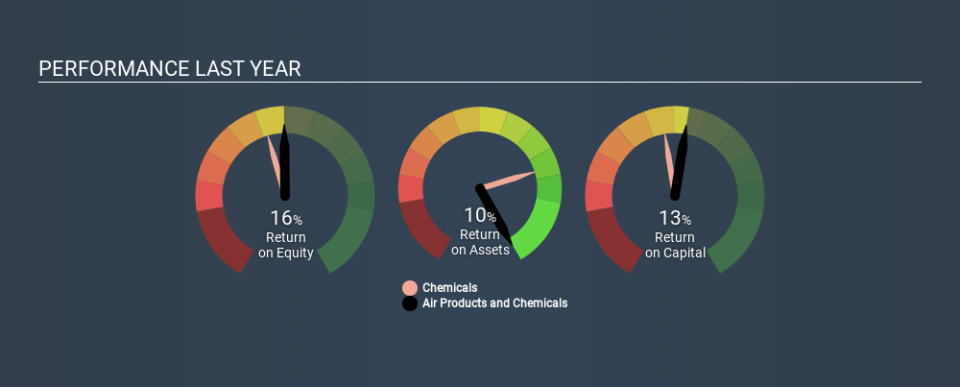Why You Should Like Air Products and Chemicals, Inc.’s (NYSE:APD) ROCE

Today we'll evaluate Air Products and Chemicals, Inc. (NYSE:APD) to determine whether it could have potential as an investment idea. In particular, we'll consider its Return On Capital Employed (ROCE), as that can give us insight into how profitably the company is able to employ capital in its business.
First up, we'll look at what ROCE is and how we calculate it. Next, we'll compare it to others in its industry. And finally, we'll look at how its current liabilities are impacting its ROCE.
Understanding Return On Capital Employed (ROCE)
ROCE measures the 'return' (pre-tax profit) a company generates from capital employed in its business. In general, businesses with a higher ROCE are usually better quality. Ultimately, it is a useful but imperfect metric. Author Edwin Whiting says to be careful when comparing the ROCE of different businesses, since 'No two businesses are exactly alike.
How Do You Calculate Return On Capital Employed?
Analysts use this formula to calculate return on capital employed:
Return on Capital Employed = Earnings Before Interest and Tax (EBIT) ÷ (Total Assets - Current Liabilities)
Or for Air Products and Chemicals:
0.13 = US$2.2b ÷ (US$19b - US$1.8b) (Based on the trailing twelve months to September 2019.)
So, Air Products and Chemicals has an ROCE of 13%.
Check out our latest analysis for Air Products and Chemicals
Is Air Products and Chemicals's ROCE Good?
ROCE is commonly used for comparing the performance of similar businesses. Air Products and Chemicals's ROCE appears to be substantially greater than the 10% average in the Chemicals industry. We consider this a positive sign, because it suggests it uses capital more efficiently than similar companies. Separate from Air Products and Chemicals's performance relative to its industry, its ROCE in absolute terms looks satisfactory, and it may be worth researching in more depth.
You can click on the image below to see (in greater detail) how Air Products and Chemicals's past growth compares to other companies.
It is important to remember that ROCE shows past performance, and is not necessarily predictive. Companies in cyclical industries can be difficult to understand using ROCE, as returns typically look high during boom times, and low during busts. ROCE is, after all, simply a snap shot of a single year. Since the future is so important for investors, you should check out our free report on analyst forecasts for Air Products and Chemicals.
Do Air Products and Chemicals's Current Liabilities Skew Its ROCE?
Short term (or current) liabilities, are things like supplier invoices, overdrafts, or tax bills that need to be paid within 12 months. The ROCE equation subtracts current liabilities from capital employed, so a company with a lot of current liabilities appears to have less capital employed, and a higher ROCE than otherwise. To counter this, investors can check if a company has high current liabilities relative to total assets.
Air Products and Chemicals has total liabilities of US$1.8b and total assets of US$19b. Therefore its current liabilities are equivalent to approximately 9.6% of its total assets. In addition to low current liabilities (making a negligible impact on ROCE), Air Products and Chemicals earns a sound return on capital employed.
The Bottom Line On Air Products and Chemicals's ROCE
This is good to see, and while better prospects may exist, Air Products and Chemicals seems worth researching further. Air Products and Chemicals shapes up well under this analysis, but it is far from the only business delivering excellent numbers . You might also want to check this free collection of companies delivering excellent earnings growth.
If you are like me, then you will not want to miss this free list of growing companies that insiders are buying.
If you spot an error that warrants correction, please contact the editor at editorial-team@simplywallst.com. This article by Simply Wall St is general in nature. It does not constitute a recommendation to buy or sell any stock, and does not take account of your objectives, or your financial situation. Simply Wall St has no position in the stocks mentioned.
We aim to bring you long-term focused research analysis driven by fundamental data. Note that our analysis may not factor in the latest price-sensitive company announcements or qualitative material. Thank you for reading.

